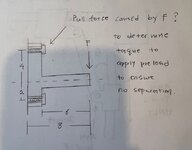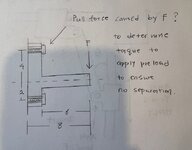Navigation
Install the app
How to install the app on iOS
Follow along with the video below to see how to install our site as a web app on your home screen.
Note: This feature may not be available in some browsers.
More options
Style variation
-
Congratulations cowski on being selected by the Eng-Tips community for having the most helpful posts in the forums last week. Way to Go!
You are using an out of date browser. It may not display this or other websites correctly.
You should upgrade or use an alternative browser.
You should upgrade or use an alternative browser.
T-Bracket Beam Analysis 1
- Thread starter E-N-E ENG
- Start date
-
1
- #2
HTURKAK
Structural
- Jul 22, 2017
- 3,355
You may look to AISC Design Guide 1 Base Plate and Anchor Rod Design.
Assuming the base plate is rectangular or square , pull force P would be approximately P=8F/6= 1.33F.
Don't pull too much the concrete may break out. ( check probable failure modes).
Assuming the base plate is rectangular or square , pull force P would be approximately P=8F/6= 1.33F.
Don't pull too much the concrete may break out. ( check probable failure modes).
My guess is there is no concrete involved here.You may look to AISC Design Guide 1 Base Plate and Anchor Rod Design.
Assuming the base plate is rectangular or square , pull force P would be approximately P=8F/6= 1.33F.
Don't pull too much the concrete may break out. ( check probable failure modes).
- Thread starter
- #5
[Moment load F x 8] / [distance from top bolt to bottom bolt 6] = 8F/6 = 4F/3You may look to AISC Design Guide 1 Base Plate and Anchor Rod Design.
Assuming the base plate is rectangular or square , pull force P would be approximately P=8F/6= 1.33F.
Don't pull too much the concrete may break out. ( check probable failure modes).
Correct explanation?
Thank you
You bet[Moment load F x 8] / [distance from top bolt to bottom bolt 6] = 8F/6 = 4F/3
Correct explanation?
Thank you
- Thread starter
- #7
Stress_Eng
Aerospace
8 x F = (1x edge + 2 + 4) x T1 + (1x edge) x T2
T1 / T2 = (4 + 2 + edge) / edge (ratio of distances from free edge contact point)
T1 = tension load at bolt 1
T2 = tension load at bolt 2
edge = bolt No.2 edge distance
Take moments at bolt 2 free edge contact point
T1 / T2 = (4 + 2 + edge) / edge (ratio of distances from free edge contact point)
T1 = tension load at bolt 1
T2 = tension load at bolt 2
edge = bolt No.2 edge distance
Take moments at bolt 2 free edge contact point
Last edited:
HTURKAK
Structural
- Jul 22, 2017
- 3,355
It is not possible to figure out the full picture ( at least for me) .At interface 1 - plate to SEPARATE (BOLT 1 IN TENSIONS)
At interface 2 - plate to COMPRESS (BOLT 2 IN MOMENT ??)
Some questions ;
- What is the red line at the interfaces ? Rubber gasket? ( the gasket will kill the joint stiffness)
- What about the load F is this a dynamic load?
- What is the shape of T bracket and how many bolts will be used?
Short answer ;
If the red lines are not gasket, if the bolts 1 and 2 both preloaded , the joint will not separate as long as the bolts do not experience tension more then preload value . ( The preload value shall be more than 4F/3.).
The bolt 1 will be in tension with preload value and will experience more tension if the joint separates,
The bolt 2 will be in tension with preload value and will not experience compression even if the joint separates,
The shear force will be resisted by the friction developing at the interface,
Bolt 2 may subject to prying forces depending on the force level .
Similar threads
- Replies
- 1
- Views
- 418
- Replies
- 7
- Views
- 936
- Replies
- 14
- Views
- 11K
- Locked
- Question
- Replies
- 3
- Views
- 3K
- Replies
- 63
- Views
- 19K



